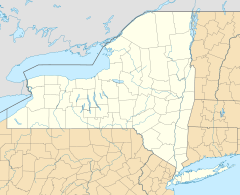Negro Brook facts for kids
Quick facts for kids Negro Brook |
|
|---|---|
|
Location of the mouth of Negro Brook
|
|
| Country | United States |
| State | New York |
| County | Delaware |
| Physical characteristics | |
| Main source | 42°31′00″N 74°50′11″W / 42.516744°N 74.8362665°W |
| River mouth | Charlotte Creek 1,250 ft (380 m) 42°28′42″N 74°50′36″W / 42.4784115°N 74.8432119°W |
Negro Brook is a small river or stream located in New York, United States. It flows through two different counties: Delaware County and Otsego County. This brook is an important part of the local water system. It eventually joins a larger waterway called Charlotte Creek. You can find where it meets Charlotte Creek just north of a place called Davenport.
Contents
What is a Brook?
A brook is a small natural freshwater stream. It is usually smaller than a river but larger than a creek. Brooks often flow into larger rivers or lakes. They are an important part of the water cycle.
How Brooks Form
Brooks usually start from springs, rainwater, or meltwater from snow. As water flows downhill, it carves out a path in the land. This path becomes a brook. Many small brooks can join together to form a larger stream or river.
Negro Brook's Journey
Negro Brook begins its journey in the hills of New York. It winds its way through the landscape, collecting water as it goes. The brook travels through parts of both Delaware and Otsego Counties. Its path helps to drain water from the surrounding land.
Where It Ends
The brook's journey ends when it flows into Charlotte Creek. This meeting point is an important spot for the local ecosystem. Charlotte Creek then continues its own path, eventually joining even larger rivers. This shows how all waterways are connected.
Why Brooks are Important
Even small brooks like Negro Brook are very important. They provide habitats for many different plants and animals. Fish, insects, and amphibians often live in or near brooks. They also provide drinking water for wildlife.
Role in Nature
Brooks help to keep the land healthy. They carry water and nutrients through the environment. They also help to prevent floods by carrying away excess water. Protecting brooks means protecting the health of the entire local area.


